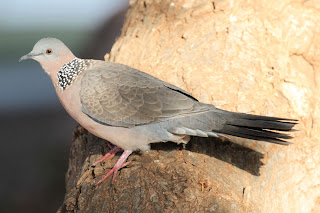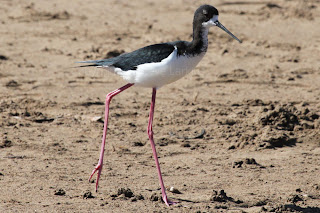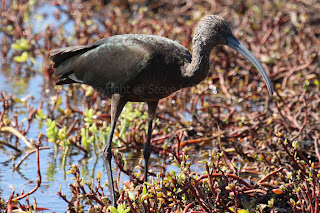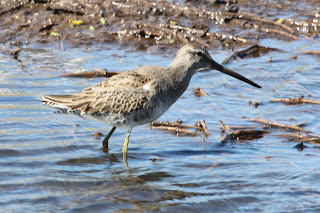Hawaiian Stilt
The Hawaiian Stilt or Ae'o has declined and some factors include that it was a popular game bird prior to 1939 and habitat loss. More wetland is being destroyed to make way for agricultural crops and 31% has vanished in the last 110 years. The introduction of mongoose, rats, cattle egrets and feral cats has also had an impact and many young stilts fall victim to predators, many of which wouldn't be here if they weren't introduced by us. They lay a clutch of up to four eggs and regularly pretend to be injured to distract potential predators.
White Faced Ibis
The White Faced Ibis measures between 46-50cm and has a 1 metre wingspan. These waders are a rare winter visitor from North America and have been seen on all main islands except Lanai. All birds seen in the Hawaiian islands have been juvenile with dull plumage and a slight sheen on their wings. They use their long curved bill to feed on leeches, snails and crayfish.
Kealia Pond, on Maui's south coast often rewards with good sightings of this Ibis.
Hawaiian Coot
At around 35cm in length, the endangered Hawaiian Coot is similar to the North American Coot in appearance. Like many other ground-nesting Hawaiian birds it is threatened by introduced predators on Maui, like the Asian Mongoose. It's population is now thought to be down to around 2000 birds.
The Coot's habitat includes freshwater lakes and coastal lagoons, with Kealia Pond being a favoured spot on Maui.
Long Billed Dowitcher
Long Billed Dowitchers migrate huge distances from their breeding grounds in the Arctic Tundra of North America and Siberia. A rare visitor to Maui from their Alaskan breeding grounds, some birds arrive in October and depart back to Alaska by the end of April.
Occasional Long Billed Dowitcher sightings also occur in western Europe and I have a picture of a Dowitcher taken at the Slimbridge Wetland Centre in Gloucestershire, England in late July 2012.
Ruddy Turnstone
The Ruddy Turnstone is a small wading bird of the Sandpiper family about 22-24cm in size. Turnstones are a common winter visitor to Maui - again from their Artic breeding grounds.
Breeding birds have reddish brown upper plumage, but most birds seen in Maui are in their winter non-breeding plumage. Ruddy Turnstones feed on insects, small crustaceans and worms in freshwater and tidal pools.
Sanderling
At about 18cm in length, the Sanderling is a common winter visitor to Maui from its breeding grounds in Alaska. It frequents coastal mudflats and sandy beaches, often in large groups.
Sanderlings travel huge distances from their artic breeding grounds, having frequently been recorded some 3000km - 10,000km from their summer home in the Canadian Tundra.
Wandering Tattler
Similar in size to a Pacific Golden Plover at about 26cm, the Wandering Tattler breeds in rocky areas close to mountain streams during the summer in north west Canada and Alaska. Watch out for them on rocky areas of Maui's shoreline and beaches. This bird was photographed on Kamaole Beach, Kihei.
Wandering Tattlers get their 'wandering' name due to their large range - with birds having been recorded wintering as far afield as the California coast and the Hawaiian islands, and some even travelling as far as South America, the South Pacific and Australia.
Pacific Golden Plover (Kolea)
The Pacific Golden Plover can be found all over Maui during the winter months, and is often seen catching insects on grassed areas such as golf courses. This bird was photographed on a Wailea golf course.
At 26 cm in size, it is similar to the American Golden Plover, but with longer legs and a more yellow colouration to its back.
Black-Crowned Night Heron

At 64cm in length, the Black Crowned Night Heron is a year-round Maui resident. It is notable for its attractive plumage, stocky appearance and long white head plumes which get erected during greeting and courtship displays.
The male (pictured right) has a black head, with a dark grey back together with lighter grey underparts. The female has lighter brown upper parts. They frequent the waters edge and are an effective ambush-predator of small fish, crustaceans, frogs and aquatic insects.
Cattle Egret
Introduced to Hawaii in 1959, the Cattle Egret is abundant on Maui. It can be seen in abundance within urban areas where it hunts small insects on grass verges and is equally at home near bodies of water, where it feeds on small insects.
The Cattle Egret is a large member of the Heron family - with about a 90cm wingspan. It gets its name through its close association with large grazing animals where is feeds off ticks and insects - often sitting on the animal's back in the process.
Nēnē
The Nēnē is the official state bird of Hawaii and is endemic to the Hawaiian islands. It is only found on of the islands of Maui, Kaua'i and Hawaii. They are a descendent of the Canada Goose (but slightly smaller at around 63cm in length), and are protected under State Law and have an endangered status. It is estimated that there are some 250 birds living on Maui and around 800 in Hawaii as a whole and the bird is the subject of a significant conservation effort. The best chance of seeing a Nēnē is on a golf course or a grassed area inside Haleakala National Park.
The picture (right) was taken at the Haleakala Park Ranger's accommodation opposite Hosmer Grove, where this bird was grazing.
Brant Goose
The Brant Goose is a rare winter visitor to Hawaii. This bird was spotted at Kealia Pond, Maui - a long way from its summer breeding ground in the Yukon Delta of Alaska and its normal wintering region which spend southern Alaska to California.
It is a small goose measuring 55 - 66cm with a black head and neck and a characteristic white patch on the neck.
Black Noddy

The Black Noddy is a member of the Tern family found in tropical and sub-tropical regions, across the Pacific.
A stronghold for the bird on Maui is the rocky outcrops and ledges of Waianapanapa State Park close to Hana in the east of the Island - where this picture was taken. The birds are present in large numbers and can be seen fishing from the trail.
The Black Noddy can also be found at Hookipa on Maui's north coast.



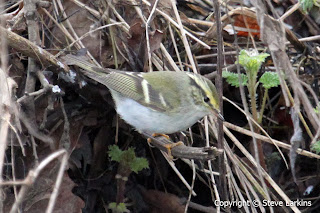






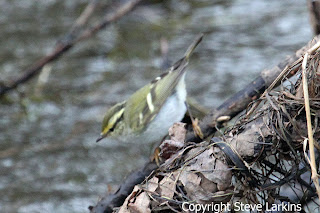



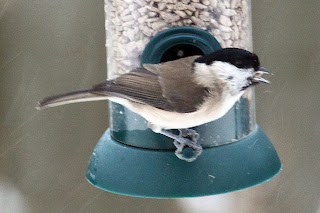

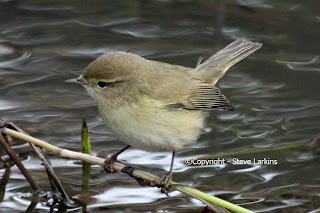



.jpg)



